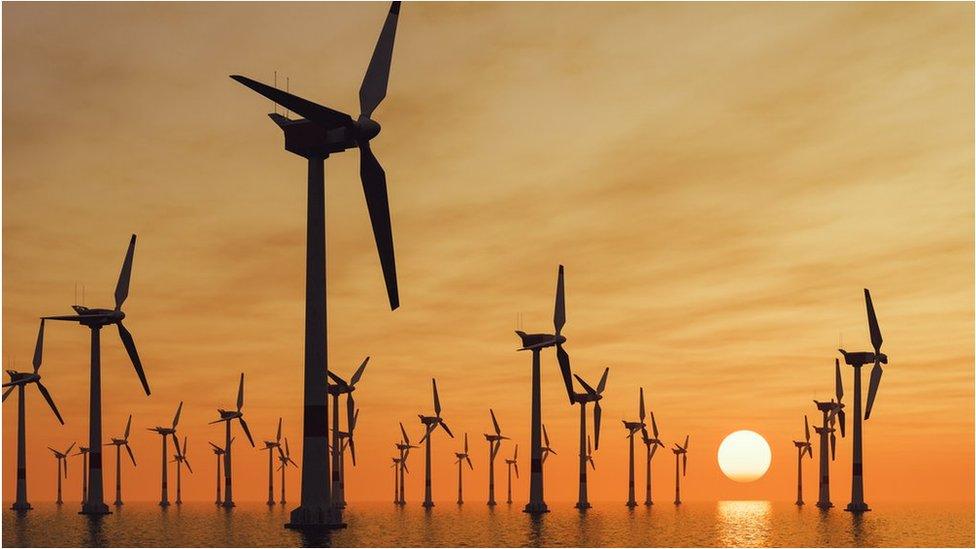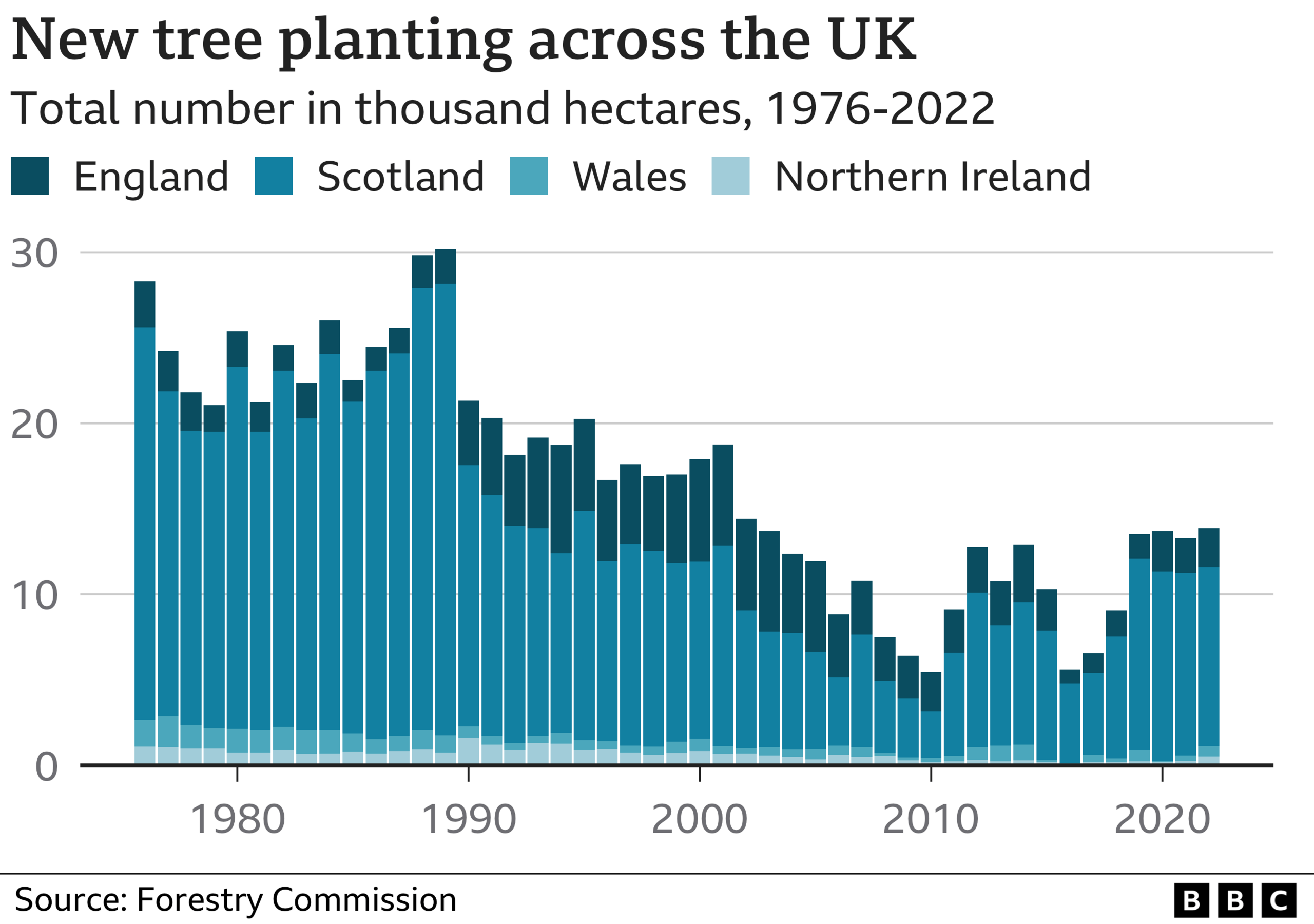Climate change: Is the UK on track to meet its net zero targets?
- Published

The UK has pledged to reduce its greenhouse gas emissions to net zero by 2050.
Net zero means a country takes as much of these planet-warming gases - such as carbon dioxide - out of the atmosphere as it puts in.
The UK has been relatively successful in cutting its emissions so far.
But the government's independent advisers, the Climate Change Committee (CCC), have expressed concerns that the UK could miss its future targets, owing to "worryingly slow" recent progress.
And in May 2024 the High Court ruled for the second time in two years that the government would have to redraft its net zero strategy because its existing plan did not provide enough detail about how future targets could be met.
What progress is being made?

Since 1990, the UK's carbon emissions from electricity supply have fallen by more than three-quarters., external
This is due to a decline in using fossil fuels - in particular coal - for electricity.
In 2023, about 47% of electricity was generated by renewables, such as wind and solar, according to provisional data, external.
That is up from 7% in 2010.
![How the sources of electricity generation within the UK have changed, 1996-2023. Key trends are the declining use of coal, sustained use of natural gas and growth of wind and solar. [May 2024]](https://ichef.bbci.co.uk/ace/standard/1920/cpsprodpb/4D36/production/_133266791_electricity_mix_simplified_may2024-nc.png)
The government pledged that all of the UK's electricity would come from low carbon sources by 2035.
It plans to increase offshore wind capacity five-fold, external by 2030, increase solar power capacity five-fold, external by 2035, and expand nuclear power, external.
However, reports by the CCC, external, the National Audit Office, external and a cross-party group of MPs, external have warned that the UK risks missing its 2035 target without clearer planning and much faster action.

Despite the push for renewable energy, the government announced in July 2023 that it was granting 100 oil and gas production licences for the North Sea.
The government says it wants to reduce the UK's reliance on imported energy such as gas from "hostile states".
But the CCC says investing in renewables would be a better way to reduce reliance on imports and bring bills down for consumers.
It says the expansion of fossil fuel production "is not in line with net zero, external".

Buildings account for about 17% of the UK's greenhouse gas emissions, external, mainly due to burning fossil fuels for heating.
The government has committed to installing 600,000 electric heat pumps a year by 2028 to replace gas boilers, but this target is "significantly off track", the CCC says, external.
In 2023, the Prime Minister increased grants to £7,500 to help homeowners in England and Wales install a heat pump. This has led to a surge in applications. , external
However, he also said around a fifth of homes would never be required to switch from a fossil fuel boiler.
This makes net zero by 2050 "considerably harder to achieve", the CCC warned.
The UK has some of the least energy-efficient homes, external in Europe. Insulation is one of the most effective ways to reduce emissions from housing, by reducing the energy needed for heating.
The government has introduced the Great British Insulation Scheme, external to help insulate around 300,000 of the poorest-performing homes.
But in September 2023, the government cancelled regulations that would have required landlords to improve the energy efficiency of private rented homes.

Transport (not including aviation and shipping) accounted for just under a quarter, external of UK emissions in 2022, making it the largest emitting sector.
The government has delayed its ban on the sale of new petrol and diesel cars from 2030 to 2035, a move which has divided the car industry.
But it has set quotas for the percentage of a manufacturer's sales that have to be zero emission, increasing year-on-year to 80% by 2030. This has been welcomed by the CCC.
Electric car sales have been faring relatively well, according to the CCC, external. In 2023, 16.5% of new car sales were battery electric vehicles, external - up from less than 2% in 2019.
![Fully electric and hybrid car sales have begun to grow more quickly in the last few years, although petrol sales remain higher. [June 2023]](https://ichef.bbci.co.uk/ace/standard/2560/cpsprodpb/D363/production/_130251145_optimised-electric_cars-nc.png)
The government wants 300,000 publicly-accessible charging points, external for electric cars by 2030, in addition to those in private homes or workplaces.
The number of public charging points had increased to more than 60,000, external by the end of April 2024 - up by 45% from the previous year- but these are not evenly distributed across the UK.
Nearly half of all new bus registrations, external were zero-emission in 2023. The government has committed further funding for regional electric bus schemes, external, but is yet to confirm when it will end the sale of diesel buses.
The government aims to remove all diesel-only trains by 2040, but the CCC argues, external it needs a clearer plan to achieve this.
Overall, the CCC says, external there has been "little progress" switching to lower carbon modes of travel, such as public transport.

Flying makes up, external about 7% of overall UK emissions, and shipping about, external 3%.
The UK has a strategy, external for delivering net zero aviation by 2050.
It has been criticised for relying too much on technologies such as cleaner fuels and zero emissions aircraft that are unlikely to be widely available anytime soon.
As a result, the CCC says, external that the government should be looking at how to manage demand rather than allowing it to grow - for example addressing private jet use and providing lower cost rail travel.
In April 2024 the government announced a target for 10% of jet fuel to come from "sustainable sources", external by 2030.
Progress has also been slow to establish a strategy to decarbonise shipping, the CCC says, external.

Agriculture and the way land is used produce 11%, external of the UK's greenhouse gas emissions.
The government released its food strategy in June 2022, but the CCC said, external it failed to deliver action to drive down emissions from agriculture at the required scale or pace.
It has also been criticised for not doing more to encourage a switch to a more sustainable diet - eating more plant-based food, for example.
Meat consumption in the UK has been falling though - down 17% in the decade to 2019.
In February 2023, the government released details, external of its long-awaited environmental land management schemes for England, replacing the EU common agricultural policy.
The schemes mean farmers can apply for public money to support activities that benefit the environment.

Trees and peatlands play important roles, external in removing carbon dioxide (CO2) from the atmosphere.
UK forest cover, external is 13%, among the lowest, external in Europe.
The government has a target to plant, external 30,000 hectares of trees a year by 2025.

However, annual UK tree planting has not risen above, external 15,000 hectares since 2001.
The UK forestry body has warned that there is "zero chance" of the UK meeting its target.
It is estimated that only around 20% of UK peatlands are in a near-natural state, external, including only 1.3% in England.
These damaged peatlands are responsible for around 5% of the UK's greenhouse gas emissions, whereas healthy peatlands would take up CO2.
The government aims to restore around 29,000 hectares of peatland a year across England, Scotland and Wales by 2025. But current levels are less than half this, external, leaving the target "significantly off track", the CCC says.

Hydrogen is a low-carbon fuel that could be used for transport, heating, power generation or energy storage.
The government considers, external hydrogen to be a critical part of future energy security and decarbonisation. It wants to have, external a 10GW hydrogen production capacity by 2030.
The industry is very much in its infancy, and the government admits, external it will need "rapid and significant scale-up" in the coming years. It has announced a series of projects and incentives for investment, external.
The government has promised a decision on the role of hydrogen in heating in 2026, but had to cancel a proposed trial because the main source of hydrogen supply was not ready.

The government sees technologies to capture the CO2 produced by power stations and industrial processes as a key part of its net zero strategy.
It aims to capture and store between 20 and 30 million tonnes of CO2 a year, external by 2030.
In March 2023, the Chancellor pledged £20bn in investment in carbon capture over the next 20 years, and several projects have been announced, external around the UK.
But the technology is still emerging, is expensive, and can only capture a portion of emissions.

Industrial emissions represent about 14%, external of the UK's total.
The government aims to cut emissions from manufacturing by about two thirds by 2035.
It has a scheme to cap the amount of emissions, external allowed by individual sectors each year, reducing that amount over time.
But the scheme risks companies shifting production to other countries.

